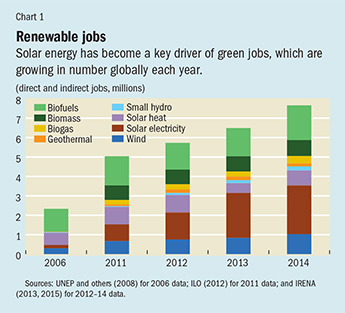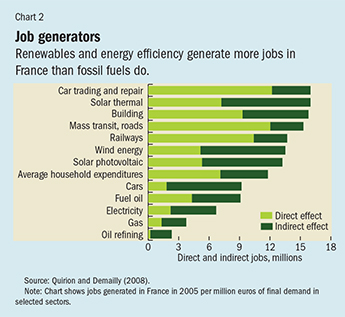Green Jobs
Finance & Development, December 2015, Vol. 52, No. 4
Peter Poschen and Michael Renner

Protecting the environment can go hand in hand with economic prosperity and job opportunities
U.S. President Barack Obama’s 2013 climate action plan and 2015 clean power plan triggered fierce debate. Senate Republican Leader Mitch McConnell denounced the proposals. “Declaring a ‘War on Coal’ is tantamount to declaring a ‘War on Jobs,’” McConnell told the Senate. “It’s tantamount to kicking the ladder out from beneath the feet of any Americans struggling in today’s economy.”
The perception that there is a trade-off—an intrinsic contradiction between protecting the climate and the environment on one hand and economic prosperity and job opportunities on the other—is common among government decision makers north and south, as well as among business leaders.
Doubt also lingers among voters. An annual poll of U.S. voters’ top concerns conducted by the Pew Research Center showed a clear pattern over the past decade. During years of high growth with ample employment opportunities, environmental sustainability and jobs and family incomes were tied as the two top concerns of the American public, at 57 percent each. But when the Great Recession started to sting in 2009, fear of job losses became a top concern of 82 percent of the U.S. public; the environment worried only 41 percent, and climate change was all but eclipsed at 30 percent (Pew Research Center, 2009).
When jobs are the priority and environmental protection is perceived as causing job losses, political will is hard to muster.
But do we really have to choose between protecting the environment and generating enough good jobs?
The answer has profound implications in a world where more than 200 million people are unemployed and almost half of those who are working have unstable and often low-paying jobs (ILO, 2015). An additional 400 million jobs will be needed to counter the unemployment that surged in the wake of the Great Recession and to offer opportunity for the young job seekers who will enter the labor market over the next decade, mostly in developing economies (ILO, 2014).
Is there a dilemma?
On the face of it, those who worry seem to have a point. The sectors that most directly contribute to climate change and other environmental degradation are agriculture, the fishing industry, forestry, energy, resource-intensive manufacturing, waste management, construction, and transportation. These sectors are the targets of policies designed to mitigate climate change, and together they employ more than 1.5 billion people, or about half the global workforce (see ILO, 2012).
But evidence accumulated over the past decade suggests that combating climate change does not preclude the growth of a healthy job market.
Green jobs—those that reduce the environmental impact of economic activity—are critical to shifting to a more environmentally sustainable economy. They fall into two broad categories: production of environmental goods such as windmills and energy-efficient buildings, and services such as recycling and work related to reducing emissions and energy and resource consumption, such as environmental and work safety and facilities and logistics management.
Two key measures for reducing greenhouse gas emissions are implementation of low-carbon energy production and lowering emissions from land use as a result of deforestation.
Cleaner energy production requires cutting back on fossil fuels, which release carbon dioxide when used to generate electricity or for heating and transportation. Substituting less-polluting fossil fuels such as natural gas for big polluters like coal and heavy oil offers temporary help. But ultimately, renewable energy such as power from water, wind, and sun and from sustainable biomass are what it will take to keep emissions from exceeding the ability of carbon sinks in the atmosphere and oceans to absorb them.

Industries producing renewable energy have started to generate a significant number of jobs. One of the first global assessments estimated direct and indirect employment in the renewable industry at 2.3 million as of 2006 (UNEP and others, 2008). Comparable assessments subsequently raised that figure to 7.7 million in 2014 (IRENA, 2015). (See Chart 1.) Well over half of these jobs are in emerging market economies such as Brazil, China, and India, which play a major role in the move toward renewable energy sources such as solar heat and power, biogas, and biofuels.
Investment in renewable energy has grown fast (though it slowed somewhat after 2011) and installed capacity has soared (UNEP, 2015; REN21, 2015). So far, however, renewables have not expanded at the expense of fossil fuels. Will there be job losses when that happens? Aren’t renewables costing jobs because they are often more expensive than the fossil alternative? And does it make a difference if the equipment for renewable energy needs to be imported? These questions flag an important point: the full economic and employment impact of a switch to low-carbon energy must be assessed for the economy as a whole.

Millions of jobs have been lost in the fossil fuel industry over recent decades, in particular in coal, where only 9.8 million jobs remained in 2014 (Greenpeace International and others, 2015). These losses are not the result of climate policies, however, but of productivity gains in coal mines and international trade. When renewables start to displace fossil fuels, the direct comparison suggests a net gain, which is confirmed by a look at the broader economy. Filling up a car’s gas tank and use of electricity in a fossil-fuel- or nuclear-based power grid do not generate many jobs, either in the energy sector or among its suppliers. These sectors generate far fewer jobs than average consumption spending does. By contrast, renewables and investment in energy efficiency generate more jobs than demand for other goods and services (see Chart 2, which illustrates the point for France).
How do the cost of renewables and the prospect of equipment imports affect net jobs? The cost of renewable energy has dropped unexpectedly quickly over the past decade. The International Renewable Energy Agency reckons renewables are already the cheapest way to provide electricity to the 1.3 billion people who lack access to clean energy, mostly in Africa and south Asia (IRENA, 2013). And power from wind is commercially viable in a growing number of countries—such as Brazil and the United States and in Europe—with extensive and diversified power grids.
While much of the debate on climate change and employment has focused on renewables, another and more significant source of jobs from decarbonization has received much less attention. Substantial efficiency gains are technically feasible and economically viable in industry, housing, transportation, and services. Businesses can make a profit and households can enjoy real savings. And spending the surplus on things other than fossil energy will boost an economy’s employment.
For example, the United States is a diversified economy that imports substantial amounts of equipment for renewables. A recent study carefully considered economy-wide effects of reducing emissions by 40 percent by 2030 through a mix of clean energy and energy efficiency (Pollin and others, 2014). It concluded that $200 billion a year in investment would generate a net gain of about 2.7 million jobs: 4.2 million in environmental goods and service sectors and their supply chains but 1.5 million lost in the shrinking fossil- and energy-intensive sectors. The net gain of 2.7 million jobs would reduce the unemployment rate in the 2030 U.S. labor market by about 1.5 percentage points—for example, from 6.5 percent to 5 percent. The authors consider this a conservative estimate; for example, it does not take into account the 1.2 to 1.8 million jobs likely gained from reinvested savings.
Other studies show similar results. A review of 30 studies covering 15 countries and the European Union as a whole found appreciable actual or potential net gains in employment (Poschen, 2015). Most studies considering emission targets in line with the ambitions announced for a Paris agreement in December find net gains on the order of 0.5 to 2.0 percent of total employment, or 15 million to 60 million additional jobs. In emerging market economies such as Brazil, China, Mauritius, and South Africa, green investment was found to accelerate economic growth and employment generation when compared with business as usual. Several studies suggest that more ambitious climate targets would generate greater gains in employment (for a discussion of particular countries, see Poschen, 2015).
In addition to new jobs, active climate policies offer other potential employment and social gains. Increasing productivity and sustainability in sectors that are critical for the climate, such as agriculture, construction, and waste management, could, for example, lift hundreds of millions of small-scale farmers out of poverty (ILO, 2012).
Policies matter
There is an important caveat, however. In addition to the emission-reduction targets themselves and the technology deployed to meet them, policy plays a crucial role in determining economic and employment outcomes. Price has long dominated economists’ debate on the right instruments for effective climate and other environmental policies. Getting the prices to speak the truth—that is, to communicate the full economic cost of consuming a good or service, including the negative impact on climate—has long been seen as the key to changing economies without destabilizing the planet’s climate system in unmanageable ways.
While few would question that correct pricing is a necessary component of an effective climate policy, it may not be sufficient. In terms of employment outcomes, how the right prices are achieved also matters. Studies consistently show that environmental tax reform (“eco-tax”) that shifts the burden away from labor and income—by reducing payroll and income levies—and toward emissions and resource consumption, through instruments such as carbon taxes, can both reduce emissions and create jobs (see ILO, 2011).
The proceeds from an eco-tax can also help defuse three negative effects of the transition to a climate-friendly economy.
The first blow is the loss of jobs in some sectors—such as coal mining, coal-fired power generation, heavy industry, and transportation—as a result of restructuring of the economy. Thanks to the lower cost of labor achieved through the reduction of payroll taxes and social protection charges, even sectors that are resource intensive can maintain employment when energy and raw material costs increase. While the limited available evidence suggests only moderate job losses from restructuring, losses do tend to occur in areas already damaged by globalization and where there are few alternatives to the mining or energy sector. In such cases, investment in social security, worker retraining, and diversification of the local economy are needed to discourage workers and politicians from the affected regions from blocking decarbonization.
A second worry concerns income rather than jobs. Increases in energy prices—whether from eco-taxes or the elimination of energy subsidies—are socially regressive. Wealthier households benefit the most from subsidies because they consume more energy, while poorer households spend a disproportionate share of their income on energy and on goods and services that are energy hogs, such as food and transportation. Efforts to end subsidies that encourage consumption and waste have been successful only when a portion of the savings has compensated those excessively affected.
The third downside is the need to adapt to climate change itself. International Labour Organization research estimates the cost of unmitigated climate change will be 7 percent of world output in 2050 (ILO, 2011); the Organisation for Economic Co-operation and Development and the World Bank expect it to be even higher. Even if there is agreement in Paris and ambitious reductions of emissions are achieved in coming decades, the greenhouse gases already in the atmosphere will do increasing damage. Even with the current less than 1 degree Celsius increase over pre-industrial temperatures, erratic weather patterns and extreme weather have begun to alter ecosystems, erode infrastructure, disrupt business activity, destroy jobs and livelihoods, and kill people on an unprecedented scale (Poschen, 2015). Climate change has also become a main driver of forced migration.
To cope with these climate stresses, investment is urgently needed to fortify affected sectors, communities, and businesses. Social protection is vital to help the poor weather the storms and droughts brought on by climate change. Employment-intensive investment can build infrastructure for adaptation and bring jobs to deprived communities in the process. Watersheds can be rehabilitated by planting trees and conserving soil to prevent floods downstream, and small dams and reservoirs can harvest water for the dry season. South Africa’s Expanded Public Works Programme pursues a mix of poverty reduction and community-led development through investment in economic, social, and environmental infrastructure, including water management, wetlands protection, and forest rehabilitation. It generates several hundred thousand jobs for local communities and vulnerable groups. India’s Rural Employment Guarantee Act provides at least 100 days of wage employment a fiscal year to every rural household whose adult members volunteer for unskilled manual work in projects such as soil and water conservation, reforestation, and flood protection. In fiscal year 2012/13, this program put 50 million rural households to work (Poschen, 2015).
Managing change
Some of the greatest opportunities to reduce emissions come from improvements in production processes and operations. Unlike changes in hardware, which take time, substantial reductions in emissions and resource consumption can be achieved in the short and medium term. The Pollution Prevention Pays program run by manufacturing conglomerate 3M since the 1970s shows what is possible. The company asks workers to identify opportunities to save resources and reduce emissions and implements those deemed viable. Between 1990 and 2011, 3M reduced its greenhouse gas emissions by 72 percent: it reduced its emission of pollutants by 1.4 million tons and saved $1.4 billion in the process (3M, 2011).
This is just one example of the many ways businesses and employer organizations, workers, and trade unions—the so-called world of work—can help achieve the transition to a low-carbon, sustainable economy. Green businesses can save through more energy- and resource-efficient processes. Managers and workers can deploy energy- and resource-efficient technology. When businesses and workers are not prepared and lack the skills to install and use new technology, the economic and environmental gains are diminished or lost altogether. Skills shortages have been a bottleneck for green growth in almost all economic sectors and virtually all countries around the world.
Ministries of labor, employer organizations, and trade unions have also made major contributions to climate change adaptation. In Germany, these three actors launched the largest program to improve energy efficiency in the world, with more than €120 billion invested to date. In Brazil, these key players have integrated renewable energy into large-scale social housing programs. In India and South Africa, they pioneered the use of social protection systems—ensuring social security and adequate working conditions—for the purpose of rehabilitation work and increased resilience to climate change. And in Bangladesh, the Ministry of Labour and Employment scaled up training for renewable energy installers, which brought solar home systems to more than 4 million rural homes.
The environmental and social challenges the world is now facing are closely linked. We have neither the time nor the money to deal with them separately or consecutively. Mobilizing employers, workers, and trade unions will be critical to putting a climate agreement into practice and garnering the needed political support. And that’s one ladder that can mean a step up for rich and poor alike. ■
Peter Poschen is Director of the International Labour Organization’s Enterprises Department, and Michael Renner is a Senior Researcher at the Worldwatch Institute.
References
3M Company, 2011, Sustainability Report (Maplewood, Minnesota).
Greenpeace International, Global Wind Energy Council, and SolarPowerEurope, 2015, Energy [R]evolution: A Sustainable World Energy Outlook 2015 (Amsterdam and Brussels).
International Labour Organization (ILO), 2011, “Economic Transition following an Emission Tax in a RBC Model with Endogenous Growth,” EC-IILS Joint Discussion Paper Series No. 17 (Geneva).
———, 2012, Working Towards Sustainable Development: Opportunities for Decent Work and Social Inclusion in a Green Economy (Geneva).
———, 2014, Global Employment Trends 2014 (Geneva).
———, 2015, World Employment and Social Outlook—Trends 2015 (Geneva).
International Renewable Energy Agency (IRENA), 2013, IOREC 2012: International Off-Grid Renewable Energy Conference. Key Findings and Recommendations (Abu Dhabi).
———, 2015, Renewable Energy and Jobs: Annual Review 2015 (Abu Dhabi).
Pollin, Robert, Heidi Garrett-Peltier, James Heintz, and Bracken Hendricks, 2014, “Green Growth: A U.S. Program for Controlling Climate Change and Expanding Job Opportunities,” Center for American Progress and Political Economy Research Institute report (Washington).
Poschen, Peter, 2015, Decent Work, Green Jobs and the Sustainable Economy (Sheffield, United Kingdom: Greenleaf).
Quirion, Philippe, and Damien Demailly, 2008, –30% de CO2 = + 684000 emplois: L’équation gagnante pour la France, World Wildlife France report (Paris).
REN21, 2015, Renewables 2015 Global Status Report (Paris).
United Nations Environment Programme (UNEP), 2015, Global Trends in Renewable Energy Investment 2015, Frankfurt School-UNEP Collaborating Centre report (Frankfurt).
———, and others, 2008, Green Jobs: Towards Decent Work in a Sustainable, Low-Carbon World (Nairobi).


